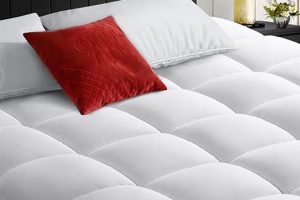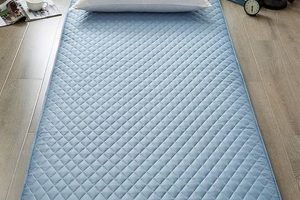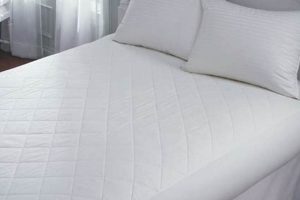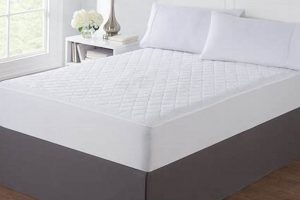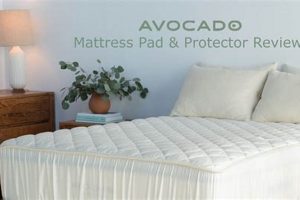A bed warmer, sized for a single occupant sleeping on a standard single mattress, provides localized and adjustable heat during sleep. Typically constructed from fabric encasing heating elements, it lies atop the mattress beneath the fitted sheet. As an example, consider a user who experiences cold feet; this device can provide targeted warmth to alleviate discomfort, promoting relaxation and potentially improving sleep quality.
The advantages of employing such a device include enhanced comfort during colder months, potential reduction in heating costs by warming only the bed rather than the entire room, and therapeutic relief for individuals with certain medical conditions such as arthritis or poor circulation. The historical context of warming beds dates back centuries, evolving from hot water bottles and warming pans to electrically powered solutions offering greater convenience and temperature control.
The remainder of this article will delve into the key features to consider when selecting a suitable product, explore the available safety features and certifications, and provide guidance on proper usage and care to ensure longevity and safe operation. A comparison of various models and their features will also be presented.
Tips
The following tips are designed to maximize the user experience, safety, and longevity of a bed-warming product intended for a twin-sized bed. Adherence to these guidelines is strongly recommended.
Tip 1: Inspect Before Use: Prior to each use, thoroughly inspect the device for any signs of damage, such as frayed wires, scorch marks, or loose connections. Do not use if any damage is detected.
Tip 2: Use Appropriate Bedding: Use the device under a fitted sheet only. Avoid placing heavy blankets or comforters directly on top of it, as this can trap heat and pose a potential fire hazard.
Tip 3: Proper Placement is Crucial: Ensure the entire device is laid flat on the mattress, avoiding any folding or bunching, especially at the connector points. Uneven heat distribution and potential overheating can result from improper placement.
Tip 4: Understand the Controls: Familiarize yourself with the control panel and temperature settings. Begin with the lowest setting and gradually increase the heat as needed. Avoid prolonged use at the highest setting.
Tip 5: Disconnect When Not in Use: Always unplug the device from the power outlet when it is not in use. This reduces the risk of electrical hazards and conserves energy.
Tip 6: Cleaning and Storage: Follow the manufacturer’s instructions for cleaning. Most units are not machine washable. Spot clean with a damp cloth and mild detergent. Ensure the device is completely dry before storing it in a cool, dry place.
Tip 7: Avoid Use with Infants or Incapacitated Individuals: This device is not recommended for use with infants, young children, or individuals who are unable to regulate their own body temperature or communicate discomfort.
By following these tips, users can ensure safe and efficient operation, minimizing the risk of accidents and maximizing the lifespan of the bed-warming product. Consistent adherence to these guidelines will contribute to a positive user experience.
The subsequent sections of this article will further explore safety certifications and troubleshooting common issues.
1. Temperature Control Precision
Temperature control precision in a bed-warming device designed for single beds is a critical feature directly impacting user comfort and safety. Imprecise temperature regulation can lead to discomfort from overheating or insufficient warmth, potentially disrupting sleep patterns. A well-engineered heating element and control system allows users to select and maintain a consistent temperature that aligns with their individual preferences and ambient room conditions. The effectiveness of the entire product relies upon this precision; fluctuations or inconsistencies render the device unreliable and undermine its intended function. For instance, a system claiming a temperature range of 60-90 degrees Fahrenheit should demonstrably maintain setpoints within a narrow tolerance, ideally +/- 2 degrees Fahrenheit.
Several factors contribute to the achievement of this precision. Thermostat placement within the device is crucial; it must accurately reflect the temperature at the sleeping surface, not simply the internal temperature of the heating element. Feedback mechanisms, such as sensors connected to a microprocessor, allow the system to respond dynamically to changes in temperature and adjust power output accordingly. Sophisticated controllers may incorporate multiple temperature sensors at different points in the device to ensure even heating and accurate temperature readings across the entire surface area. From the end user perspective, an accessible and easily understandable temperature control interface, whether digital or analog, is essential for setting and adjusting the temperature. Some devices are equipped with multiple heat settings, while more advanced models have precise digital interfaces.
In conclusion, the degree of temperature control precision directly correlates with the overall value and usability of a single-bed heating device. Accurate and stable temperature regulation is paramount for both comfort and safety, influencing sleep quality and minimizing potential risks associated with overheating. While advanced features and materials contribute to the overall product, the fundamental ability to reliably and consistently deliver the desired level of warmth is a primary determinant of user satisfaction. The lack of precise control can render the product unusable in practice.
2. Safety Certifications Validity
The validity of safety certifications is paramount when evaluating a bed-warming device designed for a single bed. These certifications, issued by recognized testing organizations, attest to the product’s adherence to established safety standards. A lapse or absence of valid certifications indicates potential risks associated with electrical safety, fire hazards, and exposure to harmful substances. Consider, for instance, a product bearing a UL (Underwriters Laboratories) or ETL (Intertek) mark. These marks signify that the device has undergone rigorous testing and meets stringent safety requirements concerning electrical components, flammability, and material composition. Conversely, a lack of these certifications raises concerns regarding the quality and safety of the materials used, the effectiveness of safety mechanisms, and the overall reliability of the product. The cause and effect relationship is direct: valid certifications provide assurance of safety; absence or invalidity increases the risk of harm.
The practical significance of safety certifications extends beyond mere compliance. These certifications
mandate specific design features aimed at preventing electrical shock, overheating, and other potential hazards. For example, a certified bed warmer typically incorporates over-temperature protection mechanisms that automatically shut off the device if it reaches a dangerously high temperature. Furthermore, the materials used must meet flammability standards to minimize the risk of fire. The cord and electrical components must also adhere to strict standards to prevent electrical shock. A real-life example might involve a consumer who purchases a non-certified bed warmer that malfunctions, leading to an electrical fire. In contrast, a certified product offers a significantly reduced risk due to mandatory safety features and quality control measures.
In summary, the validity of safety certifications is an indispensable component of the product. It is not merely a desirable attribute but a fundamental requirement for ensuring user safety and preventing potential harm. Challenges may arise in verifying the authenticity of certifications, given the potential for counterfeit markings. Consumers should therefore consult the certifying organization’s website to confirm the validity of any claims made by the manufacturer. Understanding the significance of these certifications and diligently verifying their validity is a crucial step in selecting a safe and reliable bed-warming device. This directly links to the overarching goal of ensuring user well-being and promoting safe consumer practices.
3. Material Durability Assurance
Material durability assurance, when considered in the context of a bed-warming device designed for a single bed, directly affects product longevity and user safety. The materials used in its construction, including the fabric, heating elements, and wiring, must withstand repeated use, temperature fluctuations, and potential physical stresses. A direct cause-and-effect relationship exists between material quality and product lifespan. Substandard materials degrade more rapidly, leading to premature failure of the heating elements, fabric tears, or electrical shorts. The importance of material durability lies in its contribution to the overall value proposition of the product, as frequent replacements or repairs negate any initial cost savings. For example, a bed warmer using low-grade polyester fabric may pill or tear after only a few washing cycles, while a device with inferior wiring could develop hot spots or electrical failures over time. High material resistance to wear ensures safer and more durable device in long term.
The practical significance of this understanding translates into informed purchasing decisions. Consumers should scrutinize product specifications, seeking details regarding the types of materials used and any testing performed to assess their durability. Certifications such as OEKO-TEX Standard 100, which indicates that the textile components have been tested for harmful substances, provide an additional layer of assurance. Furthermore, understanding the limitations of different materials is crucial. For instance, while synthetic fabrics like polyester are generally durable and easy to clean, they may be more susceptible to melting or scorching than natural fibers like cotton. User reviews and product warranties can also offer insights into the long-term performance and reliability of the materials used. Product testing ensures materials durability.
In summary, material durability assurance is a key consideration when selecting a product. The use of high-quality, durable materials extends the product’s lifespan, enhances user safety, and contributes to a more positive user experience. Challenges may arise in accurately assessing material quality prior to purchase, necessitating careful research and a critical evaluation of product specifications and certifications. Understanding the importance of durable material assures safe and long term usage.
4. Energy Efficiency Evaluation
Energy efficiency evaluation, when applied to a bed-warming device designed for single occupancy, involves a systematic assessment of its power consumption relative to its heating performance. A direct correlation exists between the energy efficiency of the device and its long-term operating cost. A bed warmer with poor energy efficiency consumes more power to achieve the same level of warmth, resulting in higher electricity bills. The importance of this evaluation stems from its impact on both the consumer’s finances and the environmental footprint of the product. For instance, a device rated at 75 watts that consistently delivers a comfortable warming experience is inherently more energy-efficient than a 150-watt device producing the same result. In a real-world scenario, comparing the kilowatt-hour consumption figures of different models over a typical heating season provides a tangible measure of their relative energy efficiency. Energy consumption is directly related to the financial impact on the consumer.
Practical evaluation methods include measuring the device’s power draw using a wattmeter while it operates at different temperature settings. Analyzing the heat-up time from a cold start to a specified temperature also provides valuable insight. Comparative tests against similar devices can further highlight differences in energy consumption. Some bed warmers incorporate energy-saving features such as automatic shut-off timers, which can significantly reduce energy waste by preventing the device from running unnecessarily throughout the night. Furthermore, the design of the heating element itself can influence energy efficiency; some designs distribute heat more evenly and effectively than others, requiring less power to maintain a consistent temperature. User considerations such as the thickness of bedding used over the heating device can also have a significant influence.
In conclusion, energy efficiency evaluation of a bed-warming device for a single bed is a critical factor in determining its overall value and sustainability. While initial purchase price is a consideration, the long-term cost of operation, dictated by energy consumption, should also weigh heavily in the decision-making process. Challenges in accurately comparing energy efficiency across different models may arise due to variations in testing methodologies and reporting practices. However, by considering wattage ratings, energy-saving features, and independent reviews, consumers can make informed choices that minimize both their energy bills and their environmental impact. Efficient product minimizes long-term costs and environmental impact.
5. Compatibility Verification
Compatibility verification, when pertaining to a bed-warming device intended for a single bed, ensures the device’s dimensions and features align with the standard specifications of a twin-sized mattress. The correlation is direct: a mismatch in dimensions or features renders the device ineffective or unsafe. The importance of compatibility verification is rooted in preventing operational problems, such as uneven heat distribution due to inadequate coverage, or potential safety hazards arising from improper fit. For instance, a heating pad that is significantly smaller than the mattress area will create loc
alized hot spots and leave other areas cold, thereby defeating its purpose. Conversely, an oversized device may extend beyond the mattress edges, increasing the risk of damage, overheating, or entanglement. The result of correct fit is optimal heating and safety, while an improper fit leads to problems.
The practical significance of understanding proper fit is realized through careful measurement and scrutiny of product specifications. Consumers must verify that the dimensions of the bed-warming device match their mattress size and type. Special attention should be given to the position of the electrical cord and controller to ensure convenient access and minimize tripping hazards. Some manufacturers provide detailed compatibility charts or diagrams illustrating the correct placement and fit of their products on various mattress sizes. In real-world usage, a properly sized heating pad will lie flat on the mattress surface without bunching, folding, or extending beyond the edges. The connection points for the controller should be easily accessible, and the cord should not present a safety hazard. A properly fitted product integrates seamlessly with the bedding, providing consistent and comfortable warmth.
In summary, compatibility verification is a fundamental aspect. The matching of product specifications to standard mattress dimensions ensures optimal performance, user comfort, and safety. While challenges in accurately assessing product fit may arise from variations in mattress sizes and manufacturing tolerances, careful measurement, and scrutiny of product information will mitigate these risks. The ultimate goal is to create a compatible sleep environment.
Frequently Asked Questions
This section addresses common inquiries and misconceptions regarding mattress pad heaters designed for twin-sized beds. The information presented aims to provide clarity and promote safe and effective usage.
Question 1: Is it safe to leave a mattress pad heater on all night?
Leaving a mattress pad heater activated throughout the night is generally not recommended. Prolonged use at high temperature settings may lead to overheating, posing potential fire hazards and discomfort for the sleeper. Furthermore, continuous operation reduces the device’s lifespan and increases energy consumption.
Question 2: Can a mattress pad heater be used on memory foam mattresses?
The compatibility of a mattress pad heater with memory foam mattresses varies. Some manufacturers advise against using them together due to the heat-retentive properties of memory foam, which can exacerbate overheating risks. Consult the manufacturer’s instructions for both the mattress pad heater and the memory foam mattress to determine compatibility and safe usage guidelines.
Question 3: What is the typical lifespan of a mattress pad heater?
The lifespan varies based on usage frequency, maintenance practices, and the quality of materials used in its construction. With proper care and adherence to manufacturer’s instructions, a typical mattress pad heater may last between three and five years. Visible signs of wear, such as frayed wires or uneven heating, indicate the need for replacement.
Question 4: How should a mattress pad heater be cleaned?
Cleaning procedures vary depending on the model. Most mattress pad heaters are not machine washable. Spot cleaning with a damp cloth and mild detergent is generally recommended. Always disconnect the device from the power outlet before cleaning and ensure it is completely dry before storage or reuse.
Question 5: Can a damaged mattress pad heater be repaired?
Repairing a damaged mattress pad heater is generally not advised. Tampering with the electrical components poses significant safety risks. If the device exhibits signs of damage, such as frayed wires, scorch marks, or malfunctioning controls, it should be replaced immediately to prevent potential hazards.
Question 6: What safety features should be considered when purchasing a mattress pad heater?
Essential safety features include overheat protection, automatic shut-off timers, and certifications from recognized testing organizations such as UL or ETL. These features ensure that the device meets established safety standards and minimizes the risk of electrical shock, fire, and other potential hazards. Prioritize products that demonstrate a commitment to safety through robust design and rigorous testing.
The information provided here serves as a general guide. Consult the manufacturer’s instructions for specific details regarding the safe and effective use of a mattress pad heater designed for twin-sized beds.
The subsequent section will explore advanced features and technological innovations in mattress pad heaters.
Conclusion
This exploration has elucidated the multifaceted aspects of the mattress pad heater twin, addressing temperature control precision, safety certifications, material durability, energy efficiency, and compatibility verification. Each element contributes significantly to the product’s utility, safety, and economic value. Understanding these features allows for informed decision-making.
Continued vigilance in evaluating and adhering to safety standards remains paramount. Technological advancements may further refine these devices, but the underlying principles of safety, efficiency, and durability should persist as guiding factors. Prioritizing these elements fosters both user well-being and responsible consumption, ensuring that the bed-warming experience remains a safe and beneficial practice.


![Top Rated: Best Mattress Pad for Back Pain Relief [Guide] Organic & Natural Mattress Buyer’s Guide: Non-Toxic Sleep Solutions Top Rated: Best Mattress Pad for Back Pain Relief [Guide] | Organic & Natural Mattress Buyer’s Guide: Non-Toxic Sleep Solutions](https://mattressworldpa.com/wp-content/uploads/2025/07/th-4688-300x200.jpg)
